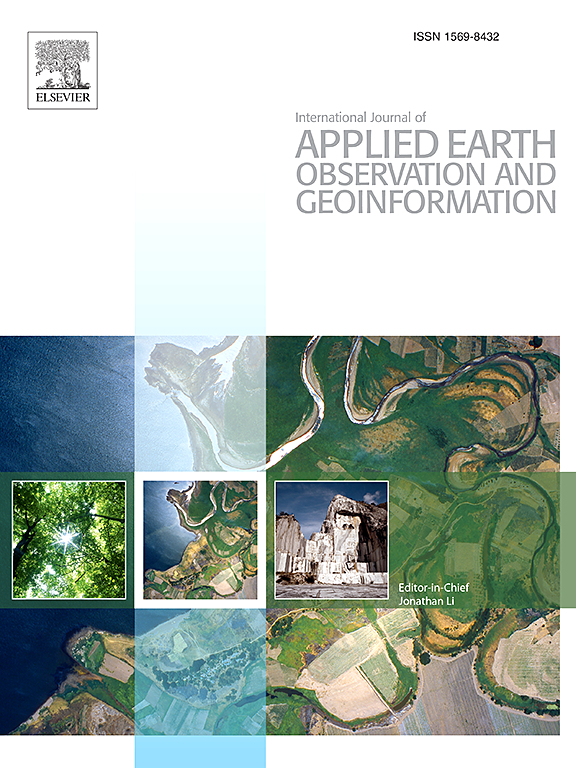Variation mechanisms of suspended sediment concentration in complex estuary determined through remote sensing, observation and modeling coupling
IF 7.6
Q1 REMOTE SENSING
International journal of applied earth observation and geoinformation : ITC journal
Pub Date : 2025-04-21
DOI:10.1016/j.jag.2025.104539
引用次数: 0
Abstract
Suspended sediments are vital indicators of water quality, so understanding the dynamic processes and influence factors of suspended sediment concentration (SSC) is crucial in estuaries or coastal waters. This study presents a comprehensive strategy for coupling several methods of remote sensing, field observation, and numerical simulation to systematically study spatio-temporal variability of suspended sediment in the Liao River Estuary (LRE) and Daliao River Estuary (DLRE), and then driving forces are analyzed. The SSC retrieval algorithm is suitable to interpret the dynamic SSC changes in shallow and turbid waters of the LRE and the DLRE. The results indicated that the SSC is higher during the muximum period of flood and ebb tide velocities but lower near the periods of flood and ebb slacks. SSC of the LRE and the DLRE is higher in spring tide cycle than that in neap tide under similar wind conditions. Wind conditions and waves caused by wind markedly influenced the SSC distribution in the LRE and the DLRE. Specifically, continuous turbidity zones are often formed due to sediment resuspension caused by larger bed shear stress under the action of strong southwest winds. The effect of river discharge on SSC in dry season is almost negligible in these study regions, and the river discharge during wet season leads to an increase of SSC. These results provide a fresh perspective on the complex sedimentary processes in estuary waters.
通过遥感、观测和模拟耦合确定复杂河口悬沙浓度变化机制
悬浮泥沙是水质的重要指标,因此了解悬浮泥沙浓度(SSC)的动态过程和影响因素对于河口或沿岸水域至关重要。本研究提出了将遥感、野外观测和数值模拟等多种方法耦合的综合策略,系统地研究了辽河口和大辽河口悬浮泥沙的时空变化,并对其驱动力进行了分析。结果表明,辽河河口和大辽河河口浅浊水区悬浮泥沙时空变异性较强,而大辽河河口浅浊水区悬浮泥沙时空变异性较弱。结果表明,SSC 在洪峰和退潮流速最大期间较高,而在洪峰和退潮流速较低期间较低。在相似的风力条件下,LRE 和 DLRE 的 SSC 在春潮周期比在低潮周期高。风力条件和风力引起的波浪明显影响了泸沽湖区和大泸沽湖区的 SSC 分布。具体地说,在西南强风的作用下,河床剪应力增大,泥沙再悬浮,往往会形成连续的浊度带。在这些研究区域,枯水期河流排水量对 SSC 的影响几乎可以忽略不计,而雨季河流排水量会导致 SSC 增加。这些结果为河口水域复杂的沉积过程提供了一个全新的视角。
本文章由计算机程序翻译,如有差异,请以英文原文为准。
求助全文
约1分钟内获得全文
求助全文
来源期刊

International journal of applied earth observation and geoinformation : ITC journal
Global and Planetary Change, Management, Monitoring, Policy and Law, Earth-Surface Processes, Computers in Earth Sciences
CiteScore
12.00
自引率
0.00%
发文量
0
审稿时长
77 days
期刊介绍:
The International Journal of Applied Earth Observation and Geoinformation publishes original papers that utilize earth observation data for natural resource and environmental inventory and management. These data primarily originate from remote sensing platforms, including satellites and aircraft, supplemented by surface and subsurface measurements. Addressing natural resources such as forests, agricultural land, soils, and water, as well as environmental concerns like biodiversity, land degradation, and hazards, the journal explores conceptual and data-driven approaches. It covers geoinformation themes like capturing, databasing, visualization, interpretation, data quality, and spatial uncertainty.
 求助内容:
求助内容: 应助结果提醒方式:
应助结果提醒方式:


